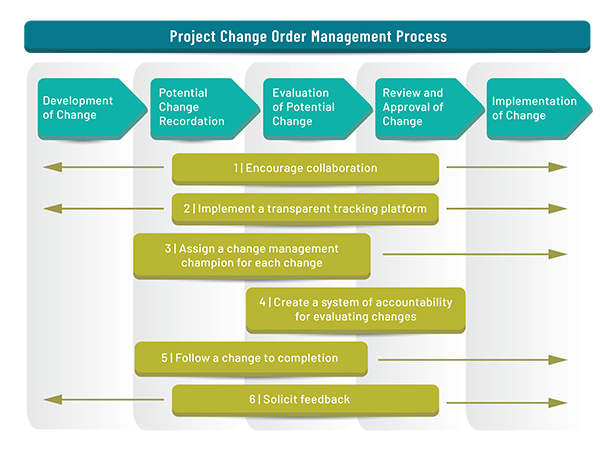
Have you ever had the thought, “why can’t we get these changes approved?” or “this change has been lingering for months, how can we move forward?” Well, you are not alone. Regardless of sector, client, or contracting mechanism, every project team encounters some degree of change – typically in the form of a change order which modifies the scope of a contract. However, the key to a successful project, and to avoiding these scenarios, is being able to manage change in an efficient, transparent, and trustworthy manner.
In the construction industry, the term “change order” generally carries a negative connotation. This perception, which typically stems from one’s prior experience and standard industry stereotypes; and is amplified by the impacts of scarce project resources – time, money, equipment, inadequate project staffing, and lack of shared common goals – can throw an entire project into a state of flux regardless of the change’s magnitude.
Utilizing a Change Management Team
To improve the misconception surrounding changes and to deliver a project successfully, we recommend that a project consider establishing a project change management team (CMT) responsible for developing a positive change culture from the outset of the project. The CMT should consist of the owner, agency construction manager, architect and/or engineer, and contractor.
The CMT can promote a successful change culture by establishing four equally important pillars of that culture:
- Developing and sharing an overall goal for the project
- Discussing examples of both positive and negative actions that further the goal
- Implementing systems and processes that are complementary to the goal
- Providing the project team regular feedback on how the effort is progressing
When both the overall project team and the CMT can internalize a change culture, it becomes the basis for a change order management program which fosters trust among the team and delivers a more successful project.
Though the goal of every project team is to be successful, the fact is our time and energy are both finite resources. Correctly implementing a robust change order management program takes time and energy and needs to complement the execution of the project. However, all too often, we are left wondering how to do it. Though every project is unique, these strategies can help create a successful change order management program.
The Project Change Order Management Process

- Encourage Collaboration. Though seemingly straightforward, this strategy is the cornerstone of a successful change order management program. All team members should feel empowered to share their individual organization’s goals and how those goals relate to the overall project. By understanding these individual goals, the team will be able to better empathize with one another and thus build trust. Further, the team members will know how to better present and share changes when they occur. This collaboration should also focus on trying to efficiently structure the change order management program. Knowing that specifications, requirements, and systems are different on every project, by understanding the other team members’ perspectives, the CMT should be able to develop project-specific processes that are efficient for all parties.
- Implement a Transparent Tracking Platform. Since changes tend to put a project into a state of flux – uncertainty – implementing a system that reduces uncertainty and increases transparency is critical. By utilizing a system to track all changes, and that is available to everyone, the CMT can confidently see, track, and report on the project to other entities both internal and external to the CMT member’s organization. The transparency of the system is key, as it enables all parties to monitor and review as needed with other project team members including superintendents, project executives, and/or subcontractors. With standardized, transparent reporting and tracking, uncertainty is decreased, enabling positive relationships to be formed more easily.
- Assign a Change Management Champion to Each Change. Changes arise due to multiple causes including additional work directed by the owner, deficient plans and specifications, schedule impacts, and differing site conditions. Though nothing replaces the owner’s representative administering the project, by assigning a change management champion to each change as it occurs, the CMT can more efficiently operate and track changes. The champion should be a member of the CMT who is specifically assigned to monitor the change from start to finish. The champion should report back to the CMT on a regular basis with progress updates. Assigning these changes to specific people with the expectation of regular updates creates a sense of accountability which will help to foster trust within the team.
- Create a System of Accountability for Evaluating Changes. If using the other strategies, the difficult part of the evaluation component is already complete – identifying the origin of the change. As such, this system should focus on setting all expectations for how to substantiate a change. Though these items may be detailed in a contract document, it is important for the entire CMT to agree to the expectations, create standard forms, and be consistent in the presentation of changes in order to allow the team to formally review changes expeditiously. To create a predictable process, all CMT members should be held to a transparent review timeline. This system allows changes to be processed and completed faster, which will foster a better jobsite environment/culture.
- Follow a Change Until it is Complete. The CMT must follow a change to final completion (i.e. its incorporation into the contract) and not lose focus after its approval. This focus allows not only an accurate recordation of the change but also allows the team to develop a sense of fairness since all parties, regardless of when they become involved in the change, will be held accountable.
- Solicit Feedback. The CMT must be committed to continual improvement. Because every project team is different, and small changes could make a huge impact, the CMT should not be afraid to make changes to the process. Evaluating proposed changes to the process, which should come from feedback collected from all project team members, will help build trust and a system that seamlessly integrates into the project.
When evaluating these change order management strategies, it is important to see how to promote both the development of trust and increased project efficiency. Projects that have implemented these strategies tend to see a 21% -26% decrease in the time spent managing the change process.
We all know change is going to happen on a construction project, we just do not know to what extent. By leveraging the above strategies and developing a change order management program founded on trust among all team members, you will be able to create a change culture that will support the most successful project possible.
If you would like to learn more about how you can build an effective project change order management program, contact us for more information.
Related reading: Learn about the change management services MBP provided for the construction of Alice West Fleet Elementary School.




